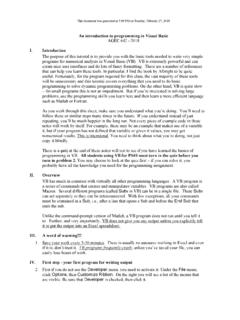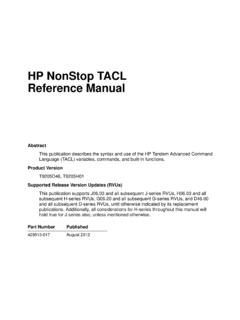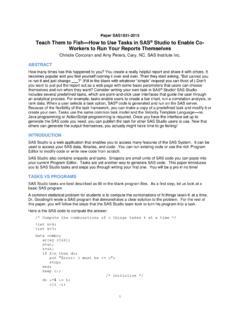Transcription of An Introduction to VBA in Excel - VU
1 An Introduction to VBA in Excel Robert L. McDonald . First draft: November, 1995. November 3, 2000. Abstract This is a tutorial showing how to use the macro facility in Microsoft Office Visual Basic for Applications to simplify analytical tasks in Excel . Contents 1 Introduction 3. 2 Calculations without VBA 3. 3 How to Learn VBA 4. 4 Calculations with VBA 5. Creating a simple function .. 5. A Simple Example of a Subroutine .. 7. Creating a Button to Invoke a Subroutine .. 7. Functions can call functions .. 8. Illegal Function Names.
2 9. Differences Between Functions and Subroutines .. 9.. Copyright 1995-2000. c Robert L. McDonald. Thanks to Jim Dana for asking stimu- lating questions about VBA.. Finance Dept, Kellogg School, Northwestern University, 2001 Sheridan Rd., Evanston, IL 60208, tel: 847-491-8344, fax: 847-491-5719, E-mail: CONTENTS 2. 5 Storing and Retrieving Variables in a Worksheet 10. Using a named range to read and write numbers from the spreadsheet .. 11. Reading and Writing to Cells Which are not Named.. 12. Using the Cells Function to Read and Write to Cells.
3 13. 6 Using Excel Functions 13. Using VBA to compute the Black-Scholes formula .. 13. The Object Browser .. 15. 7 Checking for Conditions 16. 8 Arrays 17. Defining Arrays .. 18. 9 Iterating 19. A simple for loop .. 20. Creating a binomial tree .. 20. Other kinds of loops .. 22. 10 Reading and Writing Arrays 22. Arrays as Output .. 23. Arrays as Inputs .. 24. The Array as a Collection .. 24. The Array as an Array .. 25. 11 Miscellany 26. Getting Excel to generate your macros for you .. 26. Using multiple modules .. 27. Recalculation speed.
4 27. Debugging .. 28. Creating an Add-in .. 28. 12 A Simulation Example 29. What is the algorithm? .. 29. VBA code for this example.. 30. A trick to speed up the calculations .. 32. Copyright 1995-2000, c Robert L. McDonald. November 3, 2000. 2 CALCULATIONS WITHOUT VBA 3. 1 Introduction Visual Basic for Applications, Excel 's powerful built-in programming lan- guage, permits you to easily incorporate user-written functions into a spread- You can easily calculate Black-Scholes and binomial option prices, for example. Lest you think VBA is something esoteric which you will never otherwise need to know, VBA is now the core macro language for all Mi- crosoft's office products, including Word.
5 It has also been incorporated into software from other vendors. You need not write complicated programs us- ing VBA in order for it to be useful to you. At the very least, knowing VBA will make it easier for you to analyze relatively complex problems for yourself. This document presumes that you have a basic knowledge of Excel , in- cluding the use of built-in functions and named ranges. I do not presume that you know anything about writing macros or programming. The ex- amples here are mostly related to option pricing, but the principles apply generally to any situation where you use Excel as a tool for numerical anal- ysis.
6 All of the examples here are contained in the Excel workbook 2 Calculations without VBA. Suppose you wish to compute the Black-Scholes formula in a spreadsheet. Suppose also that you have named cells2 for the stock price (s), strike price (k), interest rate (r ), time to expiration (t), volatility (v), and dividend yield (d). You could enter the following into a cell: s*exp(-d*t)*normsdist((ln(s/k)+(r-d+v 2/2)* t)/(v*t )). k * exp(-r * t)* normsdist((ln(s/k)+(r -d-v 2/2)*t)/(v*t )). Typing this formula is cumbersome, though of course you can copy the formula wherever you would like it to appear.
7 It is possible to use Excel 's data table feature to create a table of Black-Scholes prices, but this is cum- bersome and inflexible. If you want to calculate option Greeks ( delta, gamma, ) you must again enter or copy the formulas into each cell 1. This document uses keystrokes which are correct for Office 97. VBA changed dra- matically (for the better, in my opinion) between Office 95 and Office 97. The general idea remained the same, but specific keystrokes changed. So far I have not found changes required for Office 2000. 2. If you do not know what a named cell is, consult Excel 's on-line help.
8 Copyright 1995-2000, c Robert L. McDonald. November 3, 2000. 3 HOW TO LEARN VBA 4. where you want a calculation to appear. And if you decide to change some aspect of your formula, you have to hunt down all occurences and make the changes. When the same formula is copied throughout a worksheet, that worksheet potentially becomes harder to modify in a safe and reliable fash- ion. When the worksheet is to be used by others, maintainabiltiy becomes even more of a concern. Spreadsheet construction becomes even harder if you want to, for exam- ple, compute a price for a finite-lived American option.
9 There is no way to do this in one cell, so you must compute the binomial tree in a range of cells, and copy the appropriate formulas for the stock price and the option price. is is not so bad with a 3-step binomial calculation, but for 100 steps you will spend quite a while setting up the spreadsheet. You must do this separately for each time you want a binomial price to appear in the spreadsheet. And if you decide you want to set up a put pricing tree, there is no easy way to edit your call tree to price puts. Of course you can make the formulas quite flexible and general by using lots of if statements.
10 But things would become much easier if you could create your own formulas within Excel . You can with Visual Basic for Applications. 3 How to Learn VBA. Before we look at examples of VBA, it is useful to have appropriate expec- tations. There are several points: For many tasks, VBA is simple to use. We will see in a moment that creating simple add-in functions in VBA (for example to compute the Black-Scholes formula) is easy. You can do almost anything using VBA. If you can dream of something you would like Excel to do, the odds are that VBA will enable you to do it.








